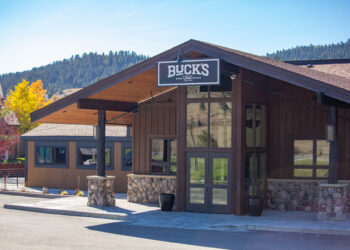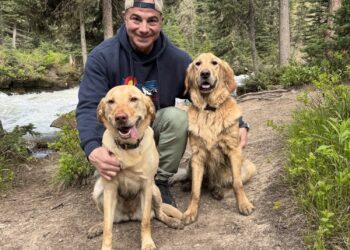By Bella Butler EBS EDITORIAL ASSISTANT
BIG SKY – Big Sky, a once-small Montana mountain town on the cusp of development, has matured into a top vacation destination for visitors from across the globe. With the swelling influx of tourists that come each summer and winter, the demand for lodging has grown exponentially.
Homeowners in the community have begun to capitalize on the expanding need, flipping their sought-after ski-town properties into short-term rentals (STRs). The Big Sky Resort Area District recognizes approximately 700 short-term rental properties, 200 of which are managed by individuals and the remainder by property management companies. While this business opportunity fills one gaping hole of lodging in the community, it may be burning another.
The spike in STRs has exacerbated Big Sky’s notorious housing crisis.
“The vast increase of people getting into the short-term market has made a big impact on people who need long-term rentals here,” said Laura Seyfang, program director for the Big Sky Community Housing Trust. “So many people have all of a sudden found that their owner has put their unit into the short-term rental market and all of a sudden they’re stuck with trying to find a place to live.”
For homeowners, however, STRs can offer up a silver platter of benefits. According to Airbnb spokeswoman Laura Rillos, 68 percent of Airbnb hosts in Montana say that operating an STR helps them afford their home. STR hosts often use revenue from hosting to pay mortgages, renovation fees and bills. For second homeowners, a common scenario in the Big Sky community, STRs aid in offsetting maintenance costs but allow for vacancy when they wish to occupy their home.
The benefits of STRs have the potential to extend beyond individual homeowners, as well. According to Rillos, 42 percent of Airbnb guest’s spending is done within the neighborhood where they stay, generating economic stimulation in local communities. STR booking groups such as Airbnb also collect the 7 percent Montana Lodging Sales Tax, which funnels into the general state fund and special revenue funds that support efforts such as tourism promotion. In 2018, Big Sky was the third largest contributor of Montana Lodging Sales Tax in the state, trailing only behind Billings and Missoula.
In Big Sky, short-term rentals are treated the same way as other businesses in the community, and owners are subject to pay 3 percent resort tax. With new short-term rentals popping up on a weekly basis, BSRAD has been charged with attentively keeping track of the small lodging businesses to ensure they comply with resort tax stipulations. The district has begun using a new software that helps comb through the internet to identify new listings.
“The majority of our existing tax payers are short-term rentals,” said Daniel Bierschwale, district manager. “It’s our largest segment of businesses throughout the community.”
In 2018, collections from short-term rentals comprised 2.4 percent of all resort tax collected in the district and collections from property management companies made up 7.3 percent, combining for a total nearing $650,000, a sum that funnels back into local community building initiatives.
In juxtaposition with the positive contributions of STRs, the STR market still remains a challenge to the housing dilemma in Big Sky.
According to the Big Sky Community Housing Trust, over 200 local renters have been forced to move due to STR conversions over the past five years. The housing trust has recognized this issue and recently kickstarted an attempt at a solution: the “Rent Local Program,” which targets homeowners’ associations in areas where locals can afford and prefer to live.
The program seeks to convert STRs into housing options through a number of services, including matching renters with homeowners, reduced property management rates, semi-annual walkthroughs to ensure unit upkeep, and lodging vouchers that give second homeowners a place to stay when they visit while their property is rented.
“In our target areas, about 12 HOAs, if we could convince about 10 percent of those folks that rent out [short term] to switch to long-term rentals, we think we would be making an incredible impact on the community for a relatively low expense,” Seyfang said. She suggests flipping STRs to long-term rentals as a lower-maintenance, lower-cost housing solution than constructing workforce housing from scratch.
Seyfang believes that many of the homeowners opting into the STR market do so in the interest of generating more revenue. However, Matt Zaremba, former owner of Running Bear Rentals, claims that in some areas and circumstances, the notion that more money can be made in the STR market is false. For homeowners using a property management company, fees will be significantly lower overall when operating a long-term rental. Zaremba said that while a property manager in Big Sky will charge 20-30 percent of gross revenue for managing an STR, the like percentage for long-term rentals is much closer to 5-10 percent.
In addition to management fees, owners running STRs may have to pay cleaning fees and must pay utilities, whereas long-term renters often assume these costs with their rental. In a resort community like Big Sky, Zaremba also suggests the effects of off-season, during which STRs likely won’t generate much, if any, revenue. Local long-term renters can provide revenue throughout the entire year.
All associated parties acknowledged that it isn’t a matter of one or the other—both long- and short-term rentals play essential roles in the Big Sky community. The trick is in effectively balancing where the two markets can meet provide the area’s needs. Seyfang recognizes in launching the housing trust’s new program that renting long term doesn’t work for everyone, but is purely circumstantial. For now, community organizations are attempting to strike the balance as Big Sky grows.














